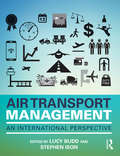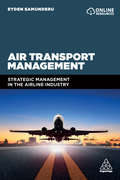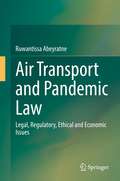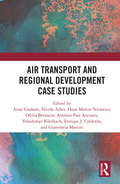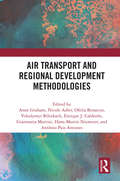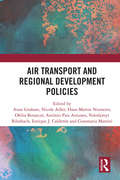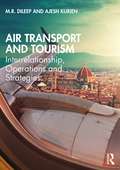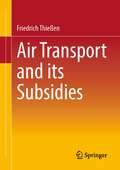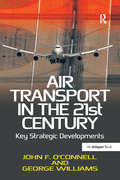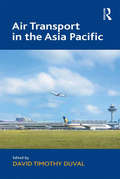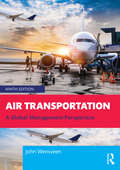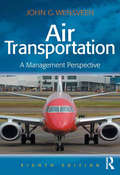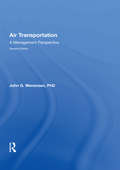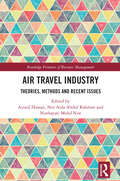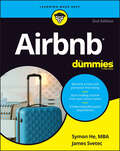- Table View
- List View
Air Transport Management: An international perspective
by Lucy Budd Stephen IsonCommercial air transport is a global multimillion dollar industry that underpins the world economy and facilitates the movement of over 3 billion passengers and 50 million tonnes of air freight worldwide each year. With a clearly structured topic-based approach, this textbook presents readers with the key issues in air transport management, including: aviation law and regulation, economics, finance, airport and airline management, environmental considerations, human resource management and marketing. The book comprises carefully selected contributions from leading aviation scholars and industry professionals worldwide. To help students in their studies the book includes case studies, examples, learning objectives, keyword definitions and ‘stop and think’ boxes to prompt reflection and to aid understanding. Air Transport Management provides in-depth instruction for undergraduate and postgraduate students studying aviation and business management-related degrees. It also offers support to industry practitioners seeking to expand their knowledge base.
Air Transport Management: Strategic Management in the Airline Industry
by Eyden SamunderuThe aviation industry is a major driver of world trade. As global markets and economies are constantly evolving, practitioners and academics need more quality information and a broader perspective of aviation management rather than just silo-based knowledge, particularly if they wish to move up the management ladder and progress. Air Transport Management presents the dynamic shifts which have influenced structural changes in the aviation industry, such as the emergence of low cost carriers. These changes have transformed the market, leading to deregulation and consolidation. The author provides a viable road map aimed at giving students and managers in the aviation industry a rigorous understanding on how to manage strategically in complex and turbulent market conditions. Air Transport Management examines the airline industry structure in terms of entry barriers, competition dynamics and competing business models. With the inclusion of fascinating case studies, this handbook assesses different business models used by international companies and proposes best fit management practices which airlines should follow in order to survive. Online supporting resources include PowerPoints of lesson plans.
Air Transport and Pandemic Law: Legal, Regulatory, Ethical and Economic Issues
by Ruwantissa AbeyratneThe book discusses legal, ethical, economic and trade aspects of the Pandemic as it affects air transport. It commences with the chronology of the virus spread and examines the various facets of human existential perspectives affected by the pandemic. Following this background is an evaluation of the effect on trade and economics, as well as the legal and regulatory structure concerning communicable diseases applicable to air transport. There is also a detailed discussion on legal liabilities and responsibilities of the State, airlines, airports and public both collectively and individually in coping with the pandemic against the backdrop of public health and the law. The Conclusion contains various recommendations on proactive measures that could be taken to ensure the establishment of a credible and effective legal and regulatory system to combat future pandemics.
Air Transport and Regional Development Case Studies
by Anne Graham Gianmaria Martini Hans-Martin Niemeier Nicole Adler Ofelia Betancor António Pais Antunes Volodymyr Bilotkach Enrique J. CalderónThis book is one of three inter-connected books related to a four-year European Cooperation in Science and Technology (COST) Action established in 2015. The Action, called Air Transport and Regional Development (ATARD), aimed to promote a better understanding of how the air transport related problems of core regions and remote regions should be addressed in order to enhance both economic competitiveness and social cohesion in Europe. This book focuses on case studies in Europe related to air transport and regional development. It is divided into four geographical regions after a general chapter that compares regional air transport connectivity between remote and central areas in Europe. The first region is Northern and Western Northern Europe (case studies related specifically to Norway, Finland, the United Kingdom, and Ireland); the second is Central and Eastern Europe, (Bulgaria, Bosnia and Herzegovina, and Poland); the third is Central Western Europe (Belgium and Switzerland); and finally, the fourth is Southern Europe (Portugal, Spain, and Italy). There is no other single source publication that currently covers this topic area in such a comprehensive manner by considering so many countries. The book aims at becoming a major reference on the topic, drawing from experienced researchers in the field, covering the diverse experience and knowledge of the members of the COST Action. The book will appeal to academics, practitioners, and policymakers who have a particular interest in acquiring detailed comparative knowledge and understanding of air transport and regional development in many different European countries. Together with the other two books (Air Transport and Regional Development Methodologies and Air Transport and Regional Development Policies), it fills a much-needed gap in the literature.
Air Transport and Regional Development Methodologies
by Anne Graham, Nicole Adler, Ofelia Betancor, Volodymyr Bilotkach, Enrique J. Calderón, Gianmaria Martini, Hans Martin Niemeier and António Pais AntunesAir Transport and Regional Development Methodologies is one of three interconnected books related to a four-year European Cooperation in Science and Technology (COST) Action established in 2015. The action, called Air Transport and Regional Development (ATARD), aimed to promote a better understanding of how the air transport–related problems of core regions and remote regions should be addressed to enhance both economic competitiveness and social cohesion in Europe. This book discusses key methodological approaches to assessing air transport and regional development, outlining their respective strengths and weaknesses. These include input- output analysis, cost benefit analysis, computable general equilibrium models, data envelopment analysis, stochastic frontier analysis, discrete choice models and game theory. Air Transport and Regional Development Methodologies aims at becoming a major reference source on the topic, drawing from experienced researchers in the field, covering the diverse experience and knowledge of the members of the COST Action. The book will be of interest to several large groups. First, it will serve as an authoritative and comprehensive reference for academics, researchers and consultants. Second, it will advise policy- makers and government organizations at European, national and regional levels. Third, it presents invaluable insights to transport companies such as airports and airline operators. Along with the other two books (Air Transport and Regional Development Policies and Air Transport and Regional Development Case Studies), it fills a much-needed gap in the literature.
Air Transport and Regional Development Policies
by Anne Graham; Nicole Adler; Hans-Martin Niemeier; Ofelia Betancor; António Pais Antunes; Volodymyr Bilotkach; Enrique J. Calderón; Gianmaria MartiniAir Transport and Regional Development Policies is one of three interconnected books related to a four-year European Cooperation in Science and Technology (COST) Action established in 2015. The Action, called Air Transport and Regional Development (ATARD), aimed to promote a better understanding of how the air transport–related problems of core regions and remote regions should be addressed in order to enhance both economic competitiveness and social cohesion in Europe. This book focuses on policy implications related to air transport and regional development. It begins with chapters that generally discuss important policy issues related to air transport and regional development in relation to connectivity and accessibility; dependency; airport governance and regulation; and air traffic control frameworks. This is followed by a number of chapters that consider government subsidies and state aid. The final chapters focus on other policy implications (tourism development, airport expansion, passenger taxation and noise control). Currently, no other single source publication covers this topic area in such a comprehensive manner, insofar as it considers so many policies and examples. The book aims at becoming a major reference source on the topic, drawing from experienced researchers in the field, covering the diverse experience and knowledge of the members of the COST Action. The book will appeal to academics, practitioners and government bodies who have a particular interest in acquiring detailed comparative knowledge and understanding of the policy implications of air transport and regional development. Along with the other two books (Air Transport and Regional Development Methodologies and Air Transport and Regional Development Case Studies) it fills a much-needed gap in the literature.
Air Transport and Tourism: Interrelationship, Operations and Strategies
by M.R. Dileep Ajesh KurienAir Transport and Tourism: Interrelationship, Operations and Strategies is a comprehensive textbook covering all major aspects of air transport from operational and managerial perspectives, as well as exploring the intricate relationship that exists between the air transport and tourism industries. The book introduces and provides in-depth coverage of the complexities of the airline industry and the tourism industry and the ways in which they are connected and impact on each other, for example, the destination–airport–airline nexus, and the roles of air transport and airlines in tourism and vice versa. Emphasis is placed on current and future trends, the impact of COVID-19, sustainability and environmental challenges throughout. Comprehensive coverage of airline operations, strategic management and planning, airport operations and air transport information technology is also provided, offering a practical viewpoint on these vital aspects of the subject. This will be the ideal introductory textbook for students of tourism and hospitality studying courses in aviation and air travel.
Air Transport and its Subsidies
by Friedrich ThießenThe book deals with the subsidies of air transport. It shows which subsidies are used to promote air transport and how the subsidies influence the various segments of air transport. The types of subsidies dealt with correspond to the OECD's delimitation. In addition to tax breaks and transfers, capital subsidies, infrastructure subsidies, regulatory deficits and non-internalised externalities are also included. The areas of air transport in which subsidies are identified are airports, airlines and air traffic control. Furthermore, aircraft manufacturers and research as well as air transport regulation, the behaviour of MPs and airport-related infrastructure are dealt with. The subject is of general and long-term interest. The book is the most comprehensive and systematic compilation of subsidies available. The result is that air transport is permeated by a largely uncoordinated system of subsidies in all its areas, the overall effects of which have not been recorded until today.
Air Transport in the 21st Century: Key Strategic Developments
by George Williams John F. O'ConnellAirlines are buffeted by fluctuating political and economic landscapes, ever-changing competition, technology developments, globalization, increasing deregulation and evolving customer requirements. As a consequence all sectors of the air transport industry are in a constant state of flux. The principle aim of this book is to review current trends in the airline industry and its related suppliers, thereby providing an insight into the forces that are changing its dynamics. The factors that are reshaping the structure of the industry are examined with a view to identifying the key issues whose impact will be critical in the future. The book features two very distinct sections. The first contains short contributions from industry executives at CEO/VP level from airlines, aircraft/engine manufacturers, safety and navigational provider organisations, who have set out their take of where the airline industry is heading. This commercial input sets the scene for the book and provides the bridge to the second section, which is composed of 18 chapters written by distinguished academic authors. Each chapter presents a valuable insight into a specific area of the air transport industry, including: airlines, airports, cargo, deregulation, the environment, navigation, strategy, information technology, security and tourism. The shared objective of the authors is to describe and explain the core competencies that are determining the current shape of the industry and to examine the forces that will change its direction going forward. The book is written in a management style and will appeal to all levels of personnel who work for airlines across the world. It is also written for airport authorities, aerospace manufacturers, regulatory and government transportation agencies, researchers and students of aviation management, transport studies, tourism and the wider air transport industry.
Air Transport in the Asia Pacific
by David Timothy DuvalAir transport in the Asia Pacific has undergone significant transformation in the last three decades. What was once a region in the shadow of larger and more prosperous continents such as North America and Europe is now at the forefront of expansion in commercial air-service networks, frequency and capacity, and the overall growth in the contribution of air transport to economies on regional and, in many cases, individual country levels. Despite this, it represents an area that is generally under-represented in the commercial air-transport academic literature. Air Transport in the Asia Pacific seeks to fill this gap. Against this context, the aim of the volume is to offer a contemporary snapshot of current academic research into commercial air transport in the Asia Pacific. While one volume cannot realistically address the complete range of identifiable issues, this book provides timely, specific and research-based studies authored by leading academics and practitioners.
Air Transportation: A Global Management Perspective
by John WensveenNow in its ninth edition, Air Transportation: A Global Management Perspective by John Wensveen is a well-proven, accessible textbook that offers a comprehensive introduction to the theory and practice of air transport management. In addition to explaining the fundamentals, the book transports the reader to the leading edge of the discipline, using past and present trends to forecast future challenges and opportunities the industry may face, encouraging the reader to think deeply about the decisions a manager implements. The word "Global" has been added to the subtitle for this edition, reflecting an increased emphasis on worldwide operations, including North America, Latin America/Caribbean, Europe, Asia-Pacific, the Middle East, and Africa. The ninth edition focuses on the "Age of Acceleration," addressing trends related to emerging technologies, such as autonomy, artificial intelligence, augmented reality, virtual reality, 3-D printing, data analytics, blockchain, cybersecurity, etc. New material includes extra information on airport management and operations, air carrier business models, aviation risk, safety and security, and how changing political landscapes impact the aviation industry. Enhanced content is supported by the addition of new chapters and online supplemental resources, including PowerPoint presentations, chapter quizzes, exam questions, and links to online resources. This wide-ranging textbook is appropriate for nearly all aviation programs that feature business and management. Its student-friendly structure and style make it highly suitable for modular courses and distance-learning programs, or for self-directed study and continuing personal professional development.
Air Transportation: A Management Perspective
by John G. WensveenAir Transportation: A Management Perspective by John Wensveen is a proven textbook that offers a comprehensive introduction to the theory and practice of air transportation management. In addition to explaining the fundamentals, the book transports the reader to the leading edge of the discipline, using past and present trends to forecast future challenges and opportunities the industry may face, encouraging the reader to really think about the decisions a manager implements. Written in an easy-to-read, easy-to-understand style, the Eighth Edition modernizes the text focusing on newly emerging management trends, innovative technology, and an increased emphasis on global changes in the industry that will change the future of aviation. New and updated material has been added throughout the text including mini case examples and supplemental presentation materials for each chapter. Air Transportation: A Management Perspective is suitable for almost all aviation programs that feature business and management. Its student-friendly structure and style make it highly suitable for modular courses and distance-learning programs, or for self-directed study and continuing personal professional development.
Air Transportation: A Management Perspective
by John WensveenNow in its Seventh Edition, Air Transportation: A Management Perspective by John Wensveen is a proven textbook that offers a comprehensive introduction to the theory and practice of air transportation management. In addition to explaining the fundamentals, this book now takes the reader to the leading edge of the discipline, using past and present trends to forecast future challenges the industry may face and encouraging the reader to really think about the decisions a manager implements. The Seventh Edition brings the text right up to date with a new opening chapter, titled 'The Airline Industry: Trends, Challenges and Strategies', setting the context for all that follows within the book, and a new section within 'International Aviation' that explores the new airline business models. New and updated material has been added throughout the text and overall presents a more international perspective. Arranged in sharply focused parts and accessible sections, the exposition is clear and reader-friendly. Air Transportation: A Management Perspective is suitable for almost all aviation programs that feature business and management. Its student-friendly structure and style make it highly suitable for modular courses and distance-learning programmes, or for self-directed study and continuing personal professional development.
Air Travel Industry: Theories, Methods and Recent Issues (Routledge Frontiers of Business Management)
by Azizul Hassan Nor Aida Abdul Rahman Nurhayati Mohd NurAs the air travel industry begins to emerge from the COVID-19 restrictions, new research must be undertaken to survey the changing business landscape. This book examines existing air travel literature, illustrates the current theories in the field, and suggests research methods for integrating them in fieldwork. The book begins by surveying the landscape of air travel research and examining key theoretical frameworks such as grounded theory, institutional theory, prospect theory, and the theory of planned behavior. It then explores when qualitative and quantitative research methods are appropriate for use in air travel research, and how they can be applied successfully. Gathered contributors from Southeast Asia and the Middle East highlight some of the latest issues, including the impacts of COVID-19 on airfreight, airline catering, and passenger perceptions of security and safety. Future directions for research are also proposed. This book will appeal to researchers and postgraduate students in the fields of air transport or aviation management, tourism marketing, and consumer behavior.
Air Travel Partnerships: How to Create Greater Value through Collaboration
by Nawal K. TanejaWhile change in the aviation sector is hardly a new phenomenon, going forward the rate of change will accelerate due to the emergence, convergence, and intersection of powerful internal and external forces. To deal with the accelerating change in the marketplace, stakeholders in the travel ecosystem need to deepen collaboration that is productive to (1) building adaptable, resilient, and lean businesses, (2) achieving growth and innovation, (3) elevating traveler experience to a much higher level, and, at the same time, (4) reducing the impact on the environment.Undoubtedly, while some innovations implemented by different aviation business sectors—to become more adaptable, more resilient, and leaner as well as to improve customer experience—have been adding some value, the innovations being introduced have been transactional, fragmented, and incremental. What is needed is a step change in proactive collaboration among different stakeholders in the air travel ecosystem at the holistic level, to cocreate value for travelers in terms of experience (relating to simplicity, convenience, and speed) and for businesses to adapt in order to reduce costs and increase profit margins.This book focuses on four types of organizations within the air travel sector: airlines, airports, aircraft manufacturers, and travel intermediaries. It provides a framework, tools, and insights to enhance collaborations by design in an age of increasing uncertainty.Air Travel Partnerships is essential reading for all executives and senior managers within airlines, airports, and air transport supporting industries.
Air Your Nightmares: How Do You Discuss Risk Without Risking the Deal?
by Danny Ertel Mark GordonRisk is an ordinary and necessary part of any negotiation process and should be treated as such. This chapter discusses how to express concerns without creating an adversarial climate.
Air, Food, and Water: Your Revenue Model--Developing a Revenue Model that Paying Customers Will Support
by Randy Komisar John MullinsThere are five elements of any company's business model that determine whether a business or organization can survive and prosper: revenue, gross margin, operating expenses, working capital, and investment. Revenue is to any business--and to most other organizations, too--as air, food, and water are to mankind--it is fundamental to survival. Without revenue, a business is as lifeless as a plant without water. This chapter examines six questions that underlie every revenue model and demonstrates how three companies--Google, Silverglide Surgical Technologies, and China's interactive gaming leader, Shanda Interactive--identified a customer problem they could resolve and developed healthy revenue models that paying customers were willing to support. The authors' goal? To help you do the same. This chapter was originally published as Chapter 3 of "Getting to Plan B: Breaking Through to a Better Business Model."
AirFox (A): Embracing the Blockchain and an ICO
by Jeffrey J. Bussgang Nathaniel Schwalb Edward B. BerkCase
AirFox (A): Embracing the Blockchain and an ICO
by Jeffrey J. Bussgang Nathaniel Schwalb Edward B. BerkCase
Airbnb
by Evan Richardson Joseph B. LassiterBrian Chesky, Joe Gebbia, and Nathan Blecharczyk, the three founders of Airbnb, an online private accommodation rental market, stared at each other across the kitchen table in their San Francisco apartment. It was March of 2009. A single sheet of paper sat on the table in front of them. The three founders were on the verge of finishing the three month program at YCombinator (YC), a business accelerator located in Mountain View, CA.
Airbnb (A)
by Benjamin Edelman Michael LucaAfter widely-publicized complaints of destructive guests and unreliable hosts, online apartment rental site Airbnb explores mechanisms to facilitate trust between guests and hosts. Flexible online reputation systems can collect and share information with ease, but Airbnb must decide which information guests and hosts should have to provide and how much flexibility each should have in selecting whom to do business with. A full-featured system could provide all the information users have been requesting, but would it be too complicated for routine use?
Airbnb During the Covid Pandemic: Stakeholder Capitalism Faces a Critical Test
by Benjamin C. Esty Allison M. CiechanoverAs the covid pandemic spread in early 2020, global travel ground to a halt. For Airbnb, the San Francisco-based platform for renting accommodations, the impact was both swift and severe as revenues plummeted more than 70% over the prior year. Responding to the sudden downturn was a challenge for CEO Brian Chesky and his leadership team because the firm had a adopted a stakeholder model with five key constituents: guests (renters), hosts (landlords), employees, communities and shareholders. While all five groups could benefit in the long-term if the firm succeeded, it was less clear how they should balance the potentially conflicting demands in the short-term particularly given the mounting losses. For example, in the face of travel restrictions, Airbnb could support guests by requiring hosts to refund deposits or could support hosts by allowing them to keep deposits. Similarly, should Airbnb use existing cash to maintain employment levels or downsize to protect capital providers? In the highly uncertain environment that existed in April 2020, Chesky and his team had to make many critical decisions with little precedent and limited information to guide them. As one of the first Silicon Valley "unicorns" to adopt a stakeholder business model, the world would be watching to see what they did, how they did it, and why.
Airbnb Emerges from the Pandemic: Lessons for Stakeholder Governance (B)
by Benjamin C. Esty Allison M. CiechanoverAs the COVID pandemic spread in early 2020, global travel ground to a halt. For Airbnb, the San Francisco-based platform for renting accommodations, the impact was both swift and severe as revenues plummeted more than 70% over the prior year. Responding to the sudden downturn was a challenge for CEO Brian Chesky and his leadership team because the firm had adopted a stakeholder model with five key constituents: guests (renters), hosts (landlords), employees, communities and shareholders. While all five groups could benefit in the long-term if the firm succeeded, it was less clear how they should balance the potentially conflicting demands in the short-term particularly given the mounting losses. For example, in the face of travel restrictions, Airbnb could support guests by requiring hosts to refund deposits or could support hosts by allowing them to keep deposits. Similarly, should Airbnb use existing cash to maintain employment levels or downsize to protect capital providers? In the highly uncertain environment that existed in April 2020, Chesky and his team had to make many critical decisions with little precedent and limited information to guide them. As one of the first Silicon Valley "unicorns" to adopt a stakeholder business model, the world would be watching to see what they did, how they did it, and why.
Airbnb For Dummies
by Symon He James SvetecMake extra money—and your guests extra happy—with Airbnb! You’ve got that spare tower, mansion, apartment, couch, or perhaps even treehouse (really—there are more than 2,400 treehouses listed on Airbnb). You’re a polite, clean, and tolerant host. And you want to make some money. Congratulations, you’re fully qualified to become part of the Airbnb revolution! Whether you’re looking to break into the business, or have already started and are researching ways of making your guests feel even more pampered as you grow your reputation and income, Airbnb for Dummies is the perfect venue for you. And this applies whether you currently own property or not! Sit back in your lounge recliner and let the owners and founders of Learnairbnb.com show you the ins and outs of the short-term rental boom that connects hosts with travelers looking for more economical and personal travel experiences across the world. Sip a refreshing drink as you learn how to manage the day-to-day—from maintaining listings to keeping things clean for your guests—and how to maximize and increase your profits. Make an attractive listing Perfect your pricing Profit without a property Create amazing guest experiences So, get hold of a copy, read it in your favorite spot, and watch as the money and excited guests beat a path to your door!
Airbnb For Dummies
by Symon He James SvetecTurn to the most-trusted guide to get started on your Airbnb adventure Airbnb For Dummies is here to help you prep your property and post your first listing on the wildly popular short-term rental site. Even if you don’t have a house, you can become an Airbnb host. A spare room at your place, a camper, a boat, a treehouse, a castle—you can turn just about anything into an Airbnb and earn additional income hosting guests. You can even offer tours around your hometown. This comprehensive resource helps you make your goals a reality, with details on how to get set up and navigate the platform and where to turn for info on local short-term rental rules, plus all the post-pandemic changes to travel and to Airbnb’s policies. Learn to attract adventurers from far and wide, with help from For Dummies experts. Decide whether becoming an Airbnb host is right for you Create an appealing listing on the Airbnb site and attract guests Host experiences and ensure the health and safety of guests Get positive reviews and improve your property’s visibilityThis book is especially for you, the first-time Airbnb host in need of a guide for creating a listing, keeping up a property, and attracting guests.
